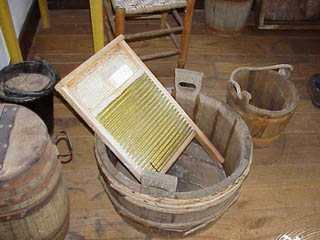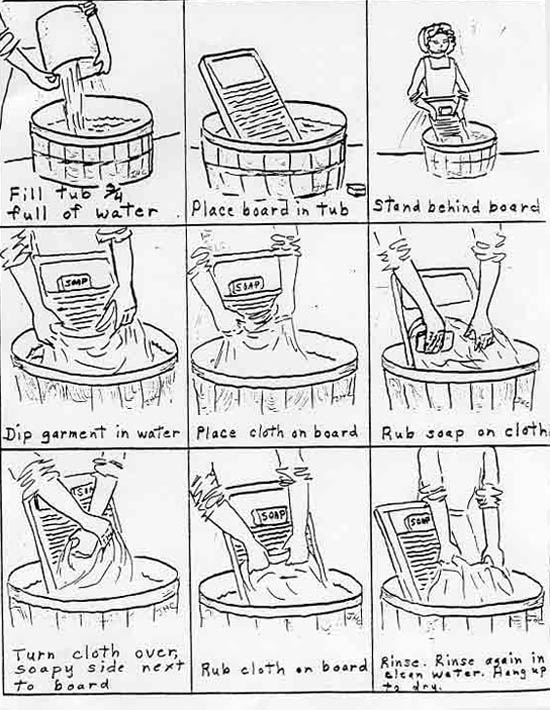 |
 | |
  | |
|
|
|
|
Fort Scott National Historic Site
Laundress-Washboards
|
|
|
|
|
|
 |
 |
| Washboard and Bucket |
 |
There are two major ways to wash clothes; by letting water flow over and through them and by abrasion. Both were used in early times and also now, in current times. An easy primitive way to wash is to put one's clothes in a large basket, fasten the basket securely in place in a flowing stream and let nature do the rest. There never was a cleaner wash.
However, if one did not have a convenient stream that was deep enough the alternative was to bring the water to some other place and use a washboard or else pound the cloths with stones on the stream bank and then rinse them in the stream. One other method was to put water in a large cauldron and boil the clothes in it; fine for tightly woven goods but not possible for hand knit socks and sweaters. Therefore such items have to be carefully sloshed in cold water, and squeezed out extremely carefully. This may have been part of the reason why sweaters were not part of early styles in this country.
The methods that laundresses in the United States Army included both boiling and the use of washboards. Factory made underwear and socks were boiled, which sanitized them at the same time. Shirts were washed on the washboards at Fort Scott.
Over the years, there have been several types of washboards. One standard type is zinc coated base metal. Some were coated with brass, and glass washing surfaced ones were also widely sold for a time.
Later, in the 1880s and 1890s, washboard surfaces were even made of what was called granite ware-colored blue and gray. We now call it-baked enamel. Such washboards are listed in the antique dealers' price books but finding any in the western states may prove unfruitful. Any type could be duplicated in wood. A large piece of wood was carved into the corrugated shape of a rubbing surface. These are not so well known because the constant wetting wore them out faster so there are not many that have survived. A few are still in the Kansas-Oklahoma area. The laundresses at Fort Scott would have used wooden washboards. Instructions for these washboards are pictured below.
|

|
| Note: the soap being used in these diagrams is being used to scrub out the stains. The wash water itself would have soap shaved into it. |
|
|
The text for this article was written by park VIP Joan House.
|
|

|
 |
|
|
|
|
|
 |
|
Did You Know?
During their free time, the officers enjoyed hunting. Captain Swords wrote "everybody here is hunting mad, hunting and dogs constitute their thoughts by day and dreams by night" Of another officer, Swords said that "wolf chasing and duck hunting" were the only things that reconciled him to the place
|
|
|
|
Last Updated: January 02, 2009 at 13:45 EST |






